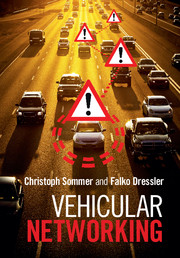4 - Access technologies
Published online by Cambridge University Press: 18 December 2014
Summary
Radio access technologies like WiFi, IEEE 802.11p, and LTE form the basis of any communication stack, and the choice of technology heavily influences application performance. They are the topic of this chapter.
In general, two families of radio access technologies can be differentiated: those based on cellular networks and those based on short-range radio. Traditionally, these two families were conceptually vastly different. Cellular networks relied on central coordination, whereas short-range radio operated in a fully distributed fashion. Cellular networks used licensed spectrum, whereas short-range radio had to make do with unlicensed spectrum. These differentiations are no longer strictly true. Cellular networks are slowly moving towards (some) distributed control, while short-range radio, particularly for inter-vehicle communication (IVC), is profitting from infrastructure support and central services. Further, short-range radio for IVC can now rely on allocated dedicated spectrum. A new trend further blends licensed and unlicensed spectrum into spectrum that has primary users, which can access the spectrum with absolute priority, but one also allows its white spaces to be filled by non-primary users.
We will take a detailed look at the concepts and the underlying principles of representative radio access technologies from both families, always with a focus on their use in vehicular networks.
This chapter is organized as follows.
• Cellular networks (Section 4.1) – We start by following the evolution of the Third Generation Partnership Project (3GPP) family of cellular networks: from GSM, via UMTS, to LTE, with a perspective on future technologies. We will always be considering both halves of a cellular network, that is, the air interface and the radio access network (RAN), as well as the core network.
• Short-range radio technologies (Section 4.2) – We then turn towards a classical short-range radio technology, following the evolution of IEEE 802.11 wireless LAN (WLAN) and its many extensions. We discuss one extension in particular detail: IEEE 802.11p, which extended WLAN for use in vehicular networks. Lastly, we discuss efforts building on WLAN to provide a complete IVC protocol suite.
[…]
- Type
- Chapter
- Information
- Vehicular Networking , pp. 106 - 135Publisher: Cambridge University PressPrint publication year: 2014



